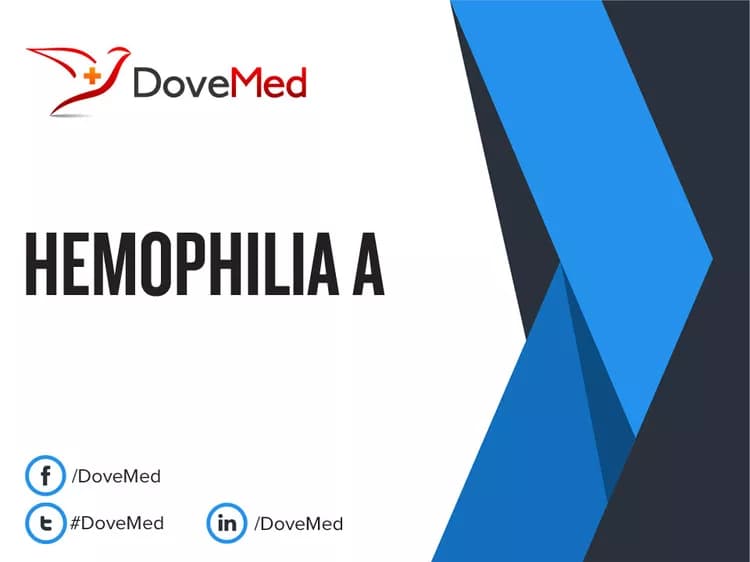What are the other Names for this Condition? (Also known as/Synonyms)
- Blood Coagulation Disorders due to Hemophilia A
- Coagulation Factor VIII Deficiency
- Procoagulant Component Coagulation Factor VIII C Deficiency
What is Hemophilia A? (Definition/Background Information)
- Hemophilia A is a genetic deficiency in clotting factor VIII, which causes increased bleeding, generally in males
- The clotting factor VIII protein itself may be abnormal or normal. When the protein is normal, factor VIII levels vary from ‘essentially absent’ to ‘moderately reduced’
- Both the treatment and prognosis for Hemophilia A is based on its severity. Often, an individualized treatment plan is devised by the healthcare provider. The prognosis depends on the severity of Hemophilia A
Who gets Hemophilia A? (Age and Sex Distribution)
- Hemophilia A occurs in approximately 1 in 5000 males
- This condition occurs more frequently in males because it is an X chromosome linked disorder. Males have only one X chromosome; thus, if the mutation is present, the disease will develop in them
- Women will be affected by the disorder only if they inherit two abnormal X chromosomes. Those who inherit only one copy of the mutation do not show any symptoms of the condition and are referred to as carriers
- All races and ethnic population are prone to Hemophilia A
What are the Risk Factors for Hemophilia A? (Predisposing Factors)
Hemophilia A risk factors include:
- Previous family history of Hemophilia A
- Male sex
It is important to note that having a risk factor does not mean that one will get the condition. A risk factor increases ones chances of getting a condition compared to an individual without the risk factors. Some risk factors are more important than others.
Also, not having a risk factor does not mean that an individual will not get the condition. It is always important to discuss the effect of risk factors with your healthcare provider.
What are the Causes of Hemophilia A? (Etiology)
- Hemophilia A genetic disorder is either inherited or acquired
- Individuals affected by inherited Hemophilia A, may:
- Either produce insufficient amounts of clotting factor VIII protein (termed as a quantitative defect)
- Or may produce a dysfunctional factor VIII protein (termed as a qualitative defect)
- Acquired Hemophilia A is extremely rare; however, it can occur when an individual produces antibodies against clotting factor VIII. This results in a deficiency of clotting factor VIII in the body
- Approximately 30% of Hemophilia A cases occur as spontaneous new mutations in individuals without a family history
What are the Signs and Symptoms of Hemophilia A?
The signs and symptoms of Hemophilia A vary, depending on the severity of the disorder. These include:
- Excessive bleeding from cuts
- Prolonged bleeding
- Pain and/or stiffness of joints
- Bleeding into the joints
- Bruising of ankles, hips, and knees
- Blood in feces or urine
- Weakness and fatigue
How is Hemophilia A Diagnosed?
Hemophilia A is diagnosed by the following tests and techniques:
Blood coagulation studies:
- Increased partial thromboplastin time (PTT)
- Normal prothrombin time (PT)
- Normal bleeding time
- Low factor VIII level or activity
- Normal fibrinogen level
- No evidence of factor VIII inhibitors
Radiology imaging techniques:
- MRI of head, spine, and joint spaces, helps detect bleeding areas
- Head computed tomography (CT) scans without contrast - this helps identify intracranial hemorrhage
Differentiating between severe Hemophilia A and Hemophilia B based on clinical presentation, is almost impossible. Though, factor assay tests can help distinguish between the two.
Many clinical conditions may have similar signs and symptoms. Your healthcare provider may perform additional tests to rule out other clinical conditions to arrive at a definitive diagnosis.
What are the possible Complications of Hemophilia A?
The possible complications associated with Hemophilia A include:
- Intracerebral hemorrhage - bleeding in the brain
- Joint deformities, due to persistent bleeding into the joint space
- Allergic reaction to infusion of blood products
- Internal bleeding in various organs
- Formation of hemophilic pseudotumor
How is Hemophilia A Treated?
Hemophilia A cannot be cured. The treatment for Hemophilia A is provided on a case-by-case basis, depending on the severity of hemophilia and may include:
- Infusion of the lacking clotting factor VIII protein
- Desmopressin - aids body to release stored factor VIII from blood vessels
- The use of genetically engineered protein factor products, if a resistance is developed
How can Hemophilia A be Prevented?
- Currently, there are no specific methods or guidelines to prevent Hemophilia A genetic condition
- Genetic testing of the expecting parents (and related family members) and prenatal diagnosis (molecular testing of the fetus during pregnancy) may help in understanding the risks better during pregnancy
- If there is a family history of the condition, then genetic counseling will help assess risks, before planning for a child
- Active research is currently being performed to explore the possibilities for treatment and prevention of inherited and acquired genetic disorders
What is the Prognosis of Hemophilia A? (Outcomes/Resolutions)
- The prognosis of Hemophilia A is dependent on the severity of the disease and an individual’s response to therapy
- With frequent checkups and efficient treatment, the affected individuals are able to lead a normal life
Additional and Relevant Useful Information for Hemophilia A:
Hemophilia B is a rare, inherited genetic disorder that prevents normal blood clot formation. In this bleeding condition, the clotting factor IX protein necessary for blood clotting, is either absent or is available only in reduced quantities.
The following article links will help you understand prothrombin time & international normalized ratio (PT/INR) and partial thromboplastin time (PTT) tests.
http://www.dovemed.com/common-procedures/procedures-laboratory/partial-thromboplastin-time-ptt-test/
Related Articles
Test Your Knowledge
Asked by users
Related Centers
Related Specialties
Related Physicians
Related Procedures
Related Resources
Join DoveHubs
and connect with fellow professionals


0 Comments
Please log in to post a comment.